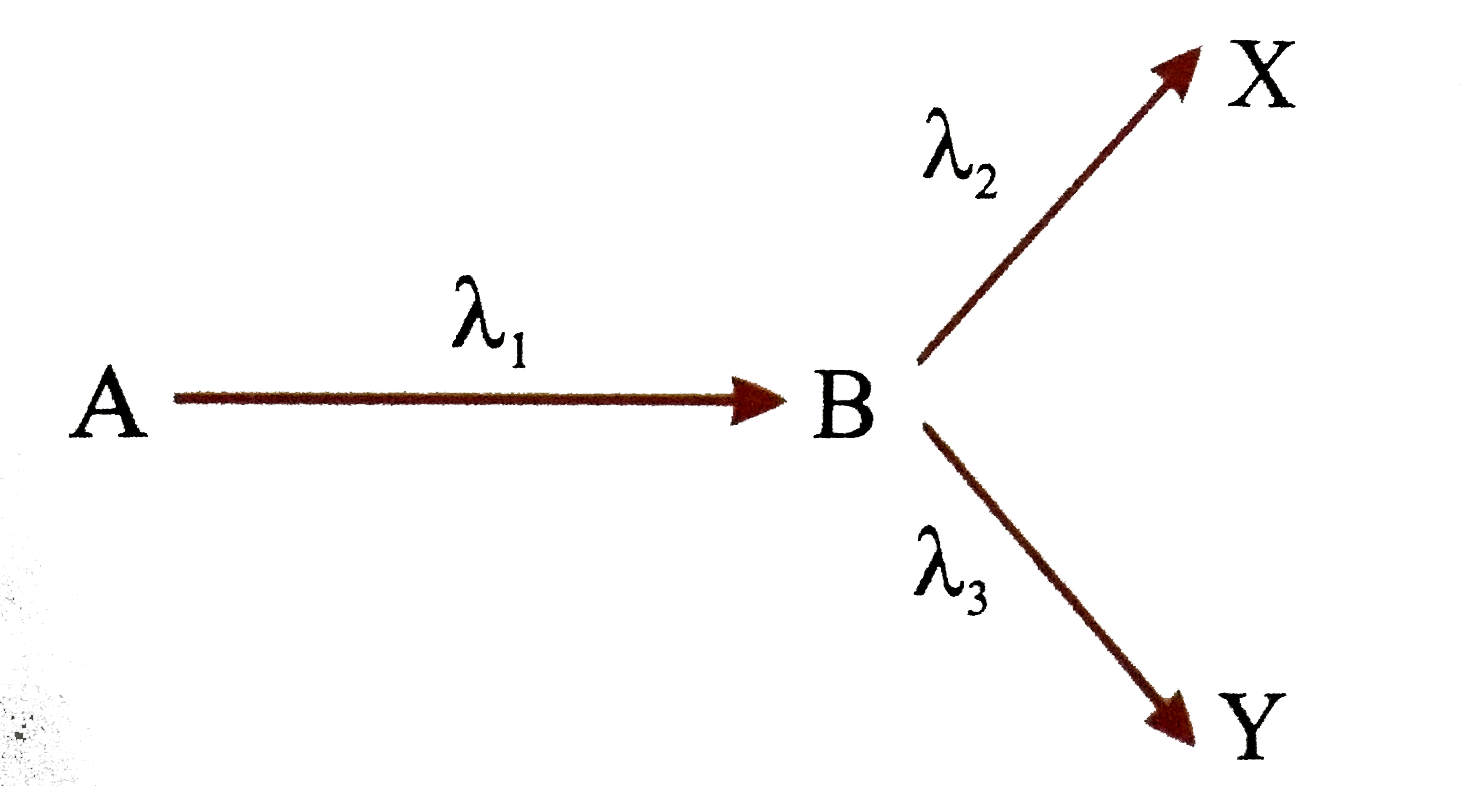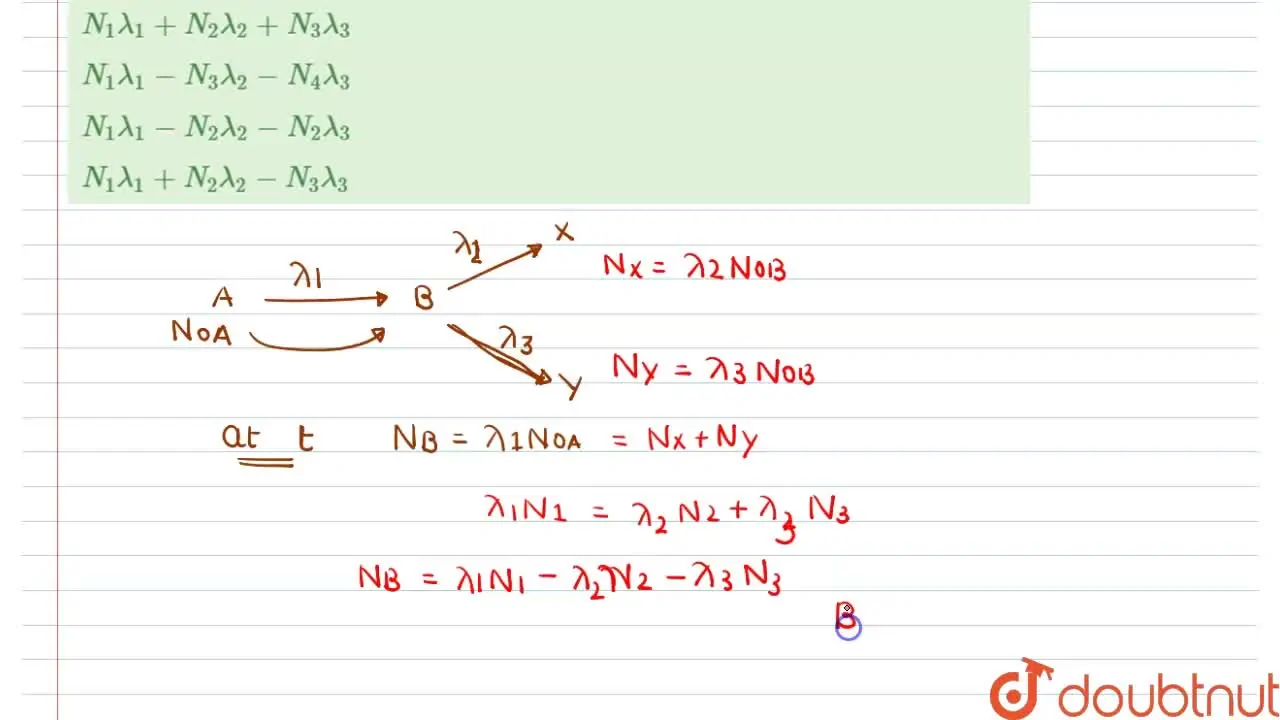Consider radioactive decay of A to B with which further decays either to X or Y, λ1,λ2 and λ3 are decay constant for A to B decay, B to X decay and Bto Y decay respectively. At t=0, the number of nuclei of A,B,X and Y are N0,N0 zero and zero respectively.
N1,N2,N3 and N4 are the number of nuclei of A,B,X and Y at any instant t.

The net rate of accumulation of B at any instant is Solution in Gujrati
N1λ1+N2λ2+N3λ3
N1λ1−N3λ2−N4λ3
N1λ1−N2λ2−N2λ3
N1λ1+N2λ2−N3λ3
The correct Answer is:C
Rate of production of B depends on the decaying rate (A) : dNAdt=−λNA=λN1
B is decaying simultaneously with two rates dNBdt=−λ2NB=−λ2N2
dNBdt=−λ3NB=−λ3N2
Number of nuclei of 'B' is =λ1N1−λ2N2−λ3N2
Related Playlists
- BOOK - ALLEN CHAPTER - SIMPLE HARMONIC MOTIONEXERCISE - Exercise - 372videos
SIMPLE HARMONIC MOTION
- BOOK - ALLEN CHAPTER - SIMPLE HARMONIC MOTIONEXERCISE - Exercise - 382videos
SIMPLE HARMONIC MOTION
- BOOK - ALLEN CHAPTER - SIMPLE HARMONIC MOTIONEXERCISE - Exercise - 352videos
SIMPLE HARMONIC MOTION
- BOOK - ALLEN CHAPTER - RACEEXERCISE - Basic Maths (Wave Motion & Dopplers Effect) (Stationary waves & doppler effect, beats)25videos
RACE
- BOOK - ALLEN CHAPTER - TEST PAPEREXERCISE - PHYSICS4videos
TEST PAPER
Similar Questions
Two radiactive material A1 and A2 have decay constants of 10λ0 and λ0. If initially they have same number of nyclei, the ratio of number of their undecayed nuclei will be (1e) after a time
13:54View SolutionCut off potential for a metal in photoclectric effect for light of wavelength λ1,λ2 and λ3 is found to be V1,V2 and V3 volts , If V1,V2 and V3 are in Arithmetic progression then λ1,λ2 and λ3 will be in
05:22View SolutionAn electron with initial kinetic energy of 100eV is acclerated through a potential difference of 50V. Now the de-Brogile wavelength of electron becomes
05:22View SolutionThe frequency of a radar is 780 MHz. After getting reflected from an approaching aeroplane, the apparent frequency is more than the actual frequency by 2.6 kHz. The aeroplane has a speed of
04:13View SolutionChoose the correct statement:
13:50View SolutionA radioactive nucleus Xdecay to a nucleus Y with a decay with a decay Concept λx=0.1s−1,γ further decay to a stable nucleus Z with a decay constant λy=1/30s−1 initialy, there are only X nuclei and their number is N0=1020 set up the rate equations for the population of X9)YandZ The population of Y nucleus as a function of time is givenby Ny(1)=N0λxl(λx−λy))(exp(−λy1))F∈dthetimeatwhichN_(y) is maximum and determine the populastion X and Y at that instant.
01:38View SolutionConsider radioactive decay of A to B with which further decays either to X or Y , lambda_(1), lambda_(2) and lambda_(3) are decay constant for A to B decay, B to X decay and Bto Y decay respectively. At t=0 , the number of nuclei of A,B,X and Y are N_(0), N_(0) zero and zero respectively. N_(1),N_(2),N_(3) and N_(4) are the number of nuclei of A,B,X and Y at any instant t . The number of nuclei of B will first increase and then after a maximum value, it decreases for
05:34View SolutionConsider radioactive decay of A to B with which further decays either to X or Y, λ1,λ2 and λ3 are decay constant for A to B decay, B to X decay and Bto Y decay respectively. At t=0, the number of nuclei of A,B,X and Y are N0,N0 zero and zero respectively.
N1,N2,N3 and N4 are the number of nuclei of A,B,X and Y at any instant t.

At t=∞, which of following is incorrect ?04:14View SolutionNucleus A decays to B with decay constant λ1 and B decays to C with decay constant λ2. Initially at t=0 number of nuclei of A and B are 2N0 and N0 respectively. At t=to, no. of nuclei of B is 3N02 and nuclei of B stop changing. Find t0?
02:38View SolutionA radioactive substance "A" having N_(0) active nuclei at t=0 , decays to another radioactive substance "B" with decay constant lambda_(1) . B further decays to a stable substance "C" with decay constant lambda_(2) . (a) Find the number of nuclei of A, B and C time t . (b) What should be the answer of part (a) if lambda_(1) gt gt lambda_(2) and lambda_(1) lt lt lambda_(2)
07:51View SolutionAt time t=0N1 nuclei of decay constant λ1&N2 nuclei of decay constant λ2 are mixed. The decay rate of the mixture at time 't' is:
06:15View SolutionThe rate at which a particular decay process occurs in a radio active sample, is proportional to the number of radio active nuclei present. If N is the number of radio active nuclei present at some instant, the rate of change of N is (dN)/(dt) = - lambdaN . Consider radioavtive decay of A to B which may further decay, either to X or to Y, lambda_(1),lambda_(2) and lambda_(3) are decay constants for A to B decay, B to X decay and B of Y decay respectively. If at t = 0 number of nuclei of A, B, X and Y are N_(0), N_(0) , zero and zero respectively and N_(1),N_(2),N_(3),N_(4) are number of nuclei A,B,X and Y at any intant. At t = oo , which of the following is incorrect ?
01:19View SolutionNucleus A decays into B with a decay constant λ1 and B further decays into C with a decay constant λ2 . Initially, at t = 0, the number of nuclei of A and B were 3N0 and N0 respectively. If at t = t0 number of nuclei of B becomes constant and equal to 2N0, then
03:31View SolutionNucleus A decays to B with decay constant λ1 and B decays to C with decay constant λ2. Initially at t=0 number of nuclei of A and B are 2N0 and N0 respectively. At t=to, no. of nuclei of B is 3N02 and nuclei of B stop changing. Find t0?
05:52View SolutionA radioactive substance A having N0 active nuclei at t=0, decays to another radioactive substance B with decay constant λ1. B further decays to a stable substance C with decay constant λ2. (a) Find the number of nuclei of A,B and C time t. (b) What should be the answer of part (a) if λ1>>λ2 and λ1<<λ2
03:29View SolutionNucleus A decays into B with a decay constant lamda_(1) and B further decays into C with a decay constant lamda_(2) . Initially, at t = 0, the number of nuclei of A and B were 3N_(0) and N_(0) respectively. If at t = t_(0) number of nuclei of B becomes constant and equal to 2N_(0) , then
01:52View Solution


